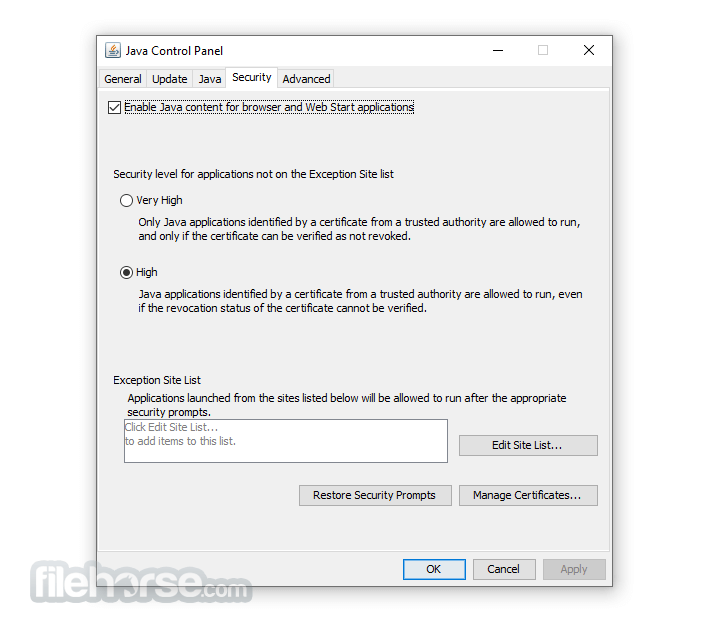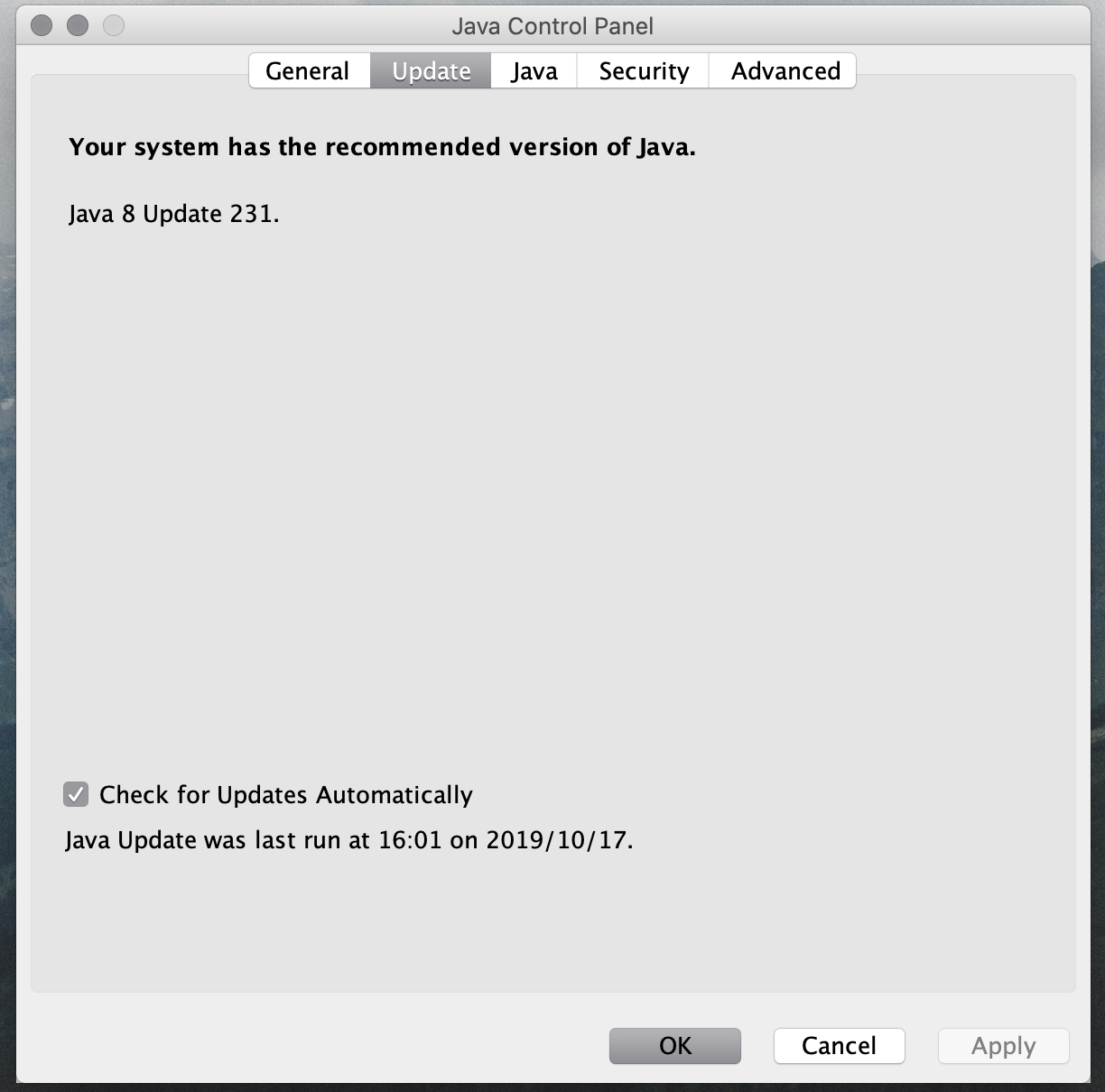Since OS X 10.7 Java is not (pre-)installed anymore, let’s fix that. As I’m writing this, Java 11.0.4 is the latest version and AdoptOpenJDK is one of the best places to find Prebuilt OpenJDK Binaries. Easy to follow details about how to install OpenJDK are available here.
However, the easiest way is to select OpenJDK 11 (LTS), the HotSpot JVM, and macOS x64, which will expose two option like these:
Clicking on “Install JDK installer”, will download the OpenJDK installer package, e.g. OpenJDK11U-jdk_x64_mac_hotspot_11.0.4_11.pkg, which when executed, will install into this location: /Library/Java/JavaVirtualMachines/adoptopenjdk-11.jdk
Almost done. After opening a terminal, the successful installation of the JDK can be confirmed like so:
Download Java for OS X directly from Oracle. Get the latest version If an app or webpage you want to use asks you to install Java software, you can download the current version of Java for OS X directly from Oracle's website.
… hopefully showing something like this:
- Java -version hopefully showing something like this: openjdk 11.0.4 2019-07-16 OpenJDK Runtime Environment AdoptOpenJDK (build 11.0.4+11) OpenJDK 64-Bit Server VM AdoptOpenJDK (build 11.0.4+11, mixed mode) JAVAHOME is an important environment variable and it’s important to get it.
- OpenJDK Runtime Environment AdoptOpenJDK (build 11.0.5+10) Eclipse OpenJ9 VM AdoptOpenJDK (build openj9-0.17.0, JRE 11 Mac OS X amd64-64-Bit Compressed References 20191031374 (JIT enabled, AOT enabled).
JAVA_HOME is an important environment variable and it’s important to get it right. Here is a trick that allows me to keep the environment variable current, even after a Java Update was installed. In ~/.zshrc, I set the variable like so:

In previous macOS versions, this was done in ~/.bash_profile. Now it’s done.
Source Code
The source code of the Java Platform, Standard Edition 11 Reference Implementations binaries is available under the GPLv2 in a single zip file.
API Specification
The API Specification of the Java Platform, Standard Edition and Java Development Kit
can be found here: https://docs.oracle.com/en/java/javase/11/docs/api/
.
This page describes how to install and uninstall JDK 8 for OS X computers.
This page has these topics:

See 'JDK 8 and JRE 8 Installation Start Here' for general information about installing JDK 8 and JRE 8.

See 'OS X Platform Install FAQ' for general information about installing JDK 8 on OS X.
System Requirements
Observe the following requirements:
Any Intel-based computer running OS X 10.8 (Mountain Lion) or later.
Administrator privileges.
Note that installing the JDK on OS X is performed on a system wide basis, for all users, and administrator privileges are required. You cannot install Java for a single user.
Installing the JDK also installs the JRE. The one exception is that the system will not replace the current JRE with a lower version. To install a lower version of the JRE, first uninstall the current version as described in 'Uninstalling the JRE'.
JDK Installation Instructions
When you install the Java Development Kit (JDK), the associated Java Runtime Environment (JRE) is installed at the same time. The JavaFX SDK and Runtime are also installed and integrated into the standard JDK directory structure.

Depending on your processor, the downloaded file has one of the following names:

Where version is 6 or later.
Download the file.
Before the file can be downloaded, you must accept the license agreement.
From either the Downloads window of the browser, or from the file browser, double click the
.dmgfile to launch it.A Finder window appears containing an icon of an open box and the name of the
.pkgfile.Double click the package icon to launch the Install app.
The Install app displays the Introduction window.
Note:
In some cases, a Destination Select window appears. This is a bug, as there is only one option available. If you see this window, select Install for all users of this computer to enable the Continue button.Click Continue.
The Installation Type window appears.
Click Install.
A window appears that says 'Installer is trying to install new software. Type your password to allow this.'
Enter the Administrator login and password and click Install Software.
The software is installed and a confirmation window appears.
Spintires is a game where you get to operate off-road trucks. These large, heavy trucks are difficult to maneuver and designed to move large cargo through muddy woodland areas that are difficult to access. It's a tremendously fun game if you have enough patience to control these mechanical giants. How to Spintires MAC Download and install for Free. Follow the instructions bellow – this is a very simple, fast and primarily free. Click the button above “Download for free now!” You start the installer game Spintires Mac; Accept User License Agreement and choose path installation; The installer will download all necessary files. Spintires free download for pc. This page contains information + tools how to port Spintires so you can play it on your Mac just like a normal application. Check also one of the other over 1000 game ports on this website! Check the homepage or portingkit.com to search and for latest news! Install is simple: 1.
Refer to
http://www.oracle.com/technetwork/java/javase/downloads/jdk-for-mac-readme-1564562.htmlfor more information about the installation.After the software is installed, delete the
.dmgfile if you want to save disk space.
Determining the Default Version of the JDK
If you have not yet installed Apple's Java OS X 2012-006 update, then you are still using a version of Apple Java 6 that includes the plug-in and the Java Preferences app. See 'Note for Users of OS X that Include Apple Java 6 Plug-in'.
Java Runtime Environment Mac Mojave
There can be multiple JDKs installed on a system, as many as you wish.
Java Runtime Environment Windows 10
When launching a Java application through the command line, the system uses the default JDK. It is possible for the version of the JRE to be different than the version of the JDK.
You can determine which version of the JDK is the default by typing java -version in a Terminal window. If the installed version is 8u6, you will see a string that includes the text 1.8.0_06. For example:
To run a different version of Java, either specify the full path, or use the java_home tool:
For more information, see the java_home(1) man page.
Uninstalling the JDK
To uninstall the JDK, you must have Administrator privileges and execute the remove command either as root or by using the sudo(8) tool.
For example, to uninstall 8u6:
Do not attempt to uninstall Java by removing the Java tools from /usr/bin. This directory is part of the system software and any changes will be reset by Apple the next time you perform an update of the OS.
